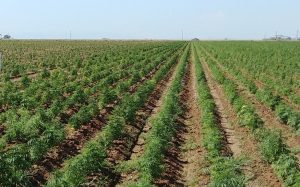
Federal crop insurance is finally coming to some hemp farmers as the U.S. Department of Agriculture (USDA) takes more steps toward adopting new rules for hemp production.
Industrial hemp farmers producing hemp for fiber, flower or seeds will be eligible for crop insurance coverage under the Whole-Farm Revenue Protection (WFRP) program for the 2020 crop year, the agriculture department announced.
The USDA’s Risk Management Agency (RMA) said the insurance will be available for farmers who are part of state or university research pilot programs, as authorized by the 2014 Farm Bill.
The move comes nearly nine months after hemp became a legal crop in the United States. For now, farmers are raising hemp at their own risk or with costly private crop insurance.
“Numerous producers are anxious for a way to protect their hemp crops from natural disasters,” RMA Administrator Martin Barbre said in a news release. “The WFRP (program) will provide a safety net for them.”
The WFRP provides coverage for agricultural commodities up to a total insured revenue of $8.5 million and is common for specialty crops, organic commodities and nontraditional crops.
To be eligible for the WFRP program, farmers must be compliant with state plans, and their hemp crops must not test over the 0.3% THC limit. Hemp will not qualify for replant payments under the policy.
Once USDA releases the much-anticipated hemp production rules, the Farm Service Agency (FSA), the Natural Resources Conservation Service and other USDA agencies will share eligibility information on their programs, including loans and disaster-assistance programs.
This will include additional insurance coverage through FSA’s Noninsured Disaster Assistance Program and RMA-administered crop insurance.
“We expect to be able to offer additional hemp coverage options as USDA continues implementing the 2018 Farm Bill,” Barbre said.
Laura Drotleff can be reached at [email protected]


